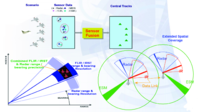
A posteriori error estimation for numerical model reduction in computational homogenization of porous media
Sign Up to like & getrecommendations! Published in 2020 at "International Journal for Numerical Methods in Engineering"
DOI: 10.1002/nme.6504
Abstract: Numerical model reduction is adopted for solving the microscale problem that arizes from computational homogenization of a model problem of porous media with displacement and pressure as unknown fields. A reduced basis is obtained for… read more here.
Keywords: computational homogenization; model; model reduction; porous media ... See more keywords

Integral equations and model reduction for fast computation of nonlinear periodic response
Sign Up to like & getrecommendations! Published in 2021 at "International Journal for Numerical Methods in Engineering"
DOI: 10.1002/nme.6740
Abstract: We propose a reformulation for a recent integral equations approach to steady‐state response computation for periodically forced nonlinear mechanical systems. This reformulation results in additional speed‐up and better convergence. We show that the solutions of… read more here.
Keywords: response; equations model; model reduction; integral equations ... See more keywords

A tangential method for the balanced truncation in model reduction
Sign Up to like & getrecommendations! Published in 2019 at "Numerical Algorithms"
DOI: 10.1007/s11075-019-00696-9
Abstract: In this paper, we present a new approach for large-scale Lyapunov matrix equations, where we present two algorithms named: Adaptive Block Tangential Lanczos-type and Arnoldi-type algorithms (ABTL and ABTA). This approach is based on the… read more here.
Keywords: method balanced; tangential method; model; model reduction ... See more keywords

Methods of Model Reduction for Large-Scale Biological Systems: A Survey of Current Methods and Trends
Sign Up to like & getrecommendations! Published in 2017 at "Bulletin of Mathematical Biology"
DOI: 10.1007/s11538-017-0277-2
Abstract: Complex models of biochemical reaction systems have become increasingly common in the systems biology literature. The complexity of such models can present a number of obstacles for their practical use, often making problems difficult to… read more here.
Keywords: large scale; reduction; biology; model reduction ... See more keywords

Temporal localized nonlinear model reduction with a priori error estimate
Sign Up to like & getrecommendations! Published in 2017 at "Applied Numerical Mathematics"
DOI: 10.1016/j.apnum.2017.02.014
Abstract: Abstract This work presents a model reduction framework using a temporal localized basis approach to efficiently reduce the simulation time for nonlinear dynamical systems with rapid changes over a short time period, and proposes a… read more here.
Keywords: priori error; temporal localized; model reduction; localized basis ... See more keywords

The Reference Point Method, a ``hyperreduction'' technique: Application to PGD-based nonlinear model reduction
Sign Up to like & getrecommendations! Published in 2017 at "Computer Methods in Applied Mechanics and Engineering"
DOI: 10.1016/j.cma.2017.04.033
Abstract: A new approximation technique, called Reference Point Method (RPM), is proposed in order to reduce the computational complexity of algebraic operations for constructing reduced-order models in the case of time dependent and/or parametrized nonlinear partial… read more here.
Keywords: pgd based; model; model reduction; order ... See more keywords

Observer design for interconnected systems with model reduction and unknown inputs
Sign Up to like & getrecommendations! Published in 2020 at "IFAC-PapersOnLine"
DOI: 10.1016/j.ifacol.2020.12.2459
Abstract: Abstract In this paper a combination of distributed parameter systems and lumped parameter systems is investigated, also known as interconnected system. In particular, the heat distribution and the influence of single chips on a base… read more here.
Keywords: observer design; design interconnected; reduction unknown; model reduction ... See more keywords

Error bounds for model reduction of feedback-controlled linear stochastic dynamics on Hilbert spaces
Sign Up to like & getrecommendations! Published in 2022 at "Stochastic Processes and their Applications"
DOI: 10.1016/j.spa.2022.03.009
Abstract: We analyze structure-preserving model order reduction methods for Ornstein-Uhlenbeck processes and linear S(P)DEs with multiplicative noise based on balanced truncation. For the first time, we include in this study the analysis of non-zero initial conditions.… read more here.
Keywords: error bounds; feedback controlled; bounds model; model reduction ... See more keywords

Symmetry in a space of conceptual variables
Sign Up to like & getrecommendations! Published in 2019 at "Journal of Mathematical Physics"
DOI: 10.1063/1.5082694
Abstract: A conceptual variable is any variable defined by a person or by a group of persons. Such variables may be inaccessible, meaning that they cannot be measured with arbitrary accuracy on the physical system under… read more here.
Keywords: space; group; conceptual variables; model reduction ... See more keywords

Model Reduction of Rich Premixed Hydrogen/air Oscillatory Flames by Global Quasi-Linearization (GQL)
Sign Up to like & getrecommendations! Published in 2021 at "Combustion Science and Technology"
DOI: 10.1080/00102202.2020.1869729
Abstract: The Global Quasi-Linearization (GQL) method for model reduction of chemical kinetics is applied to describe the very sensitive regime of the onset of the thermal-diffusion oscillations of the rich ... read more here.
Keywords: linearization gql; model reduction; quasi linearization; global quasi ... See more keywords

A note on model reduction for microelectromechanical systems
Sign Up to like & getrecommendations! Published in 2017 at "Nonlinearity"
DOI: 10.1088/1361-6544/aa4ff9
Abstract: Numerical evidence is provided that there are non-constant permittivity profiles which force solutions to a two-dimensional coupled moving boundary problem modelling microelectromechanical systems to be positive, while the corresponding small-aspect ratio model produces solutions which… read more here.
Keywords: note model; model; microelectromechanical systems; model reduction ... See more keywords